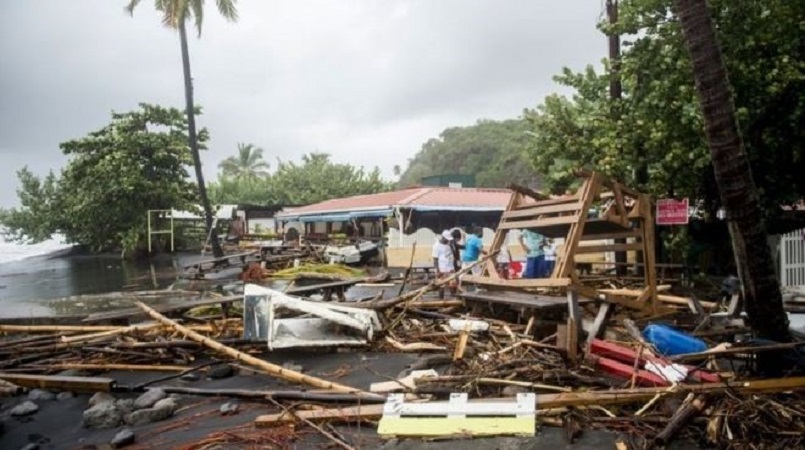
The latest major Atlantic hurricane of the season, Maria, has powered back to category five strength after pounding the Caribbean island of Dominica.
It weakened to a four after wreaking "widespread damage" on the island but is now packing maximum sustained winds of 265km/h (165mph) again.
The storm is moving roughly along the same track as Irma, this season's other category five hurricane.
At least one person was killed and two others are missing in Guadeloupe.
Local officials said one person was killed by a falling tree in the overseas French territory, while at least two more people were missing after their ship sank near Desirade, the easternmost island in the archipelago.
Heavy rainfall from Maria has begun lashing the Virgin Islands and Puerto Rico.
The governor of Puerto Rico, a US territory, has told the island's 3.5 million people to seek shelter.
Officials there fear the debris left by Irma earlier this month could now prove extremely dangerous in the winds of Maria.
The new storm is proving particularly treacherous as its strength can change dramatically in a matter of hours.
What do we know of the damage on Dominica?
The former British colony, which has a population of 72,000 and is less than 50km long and 25km wide, escaped the worst of Hurricane Irma two weeks ago.
But on Monday the eye of the new category five storm passed directly over, making landfall at 21:00 local time (01:00 GMT Tuesday). The island has no communications.
The roof of Prime Minister Roosevelt Skerrit's official residence was blown off in the storm.
"My greatest fear for the morning is that we will wake to news of serious physical injury and possible deaths as a result of likely landslides triggered by persistent rains," he said in a Facebook post.
"So far the winds have swept away the roofs of almost every person I have spoken to or otherwise made contact with. The roof to my own official residence was among the first to go and this apparently triggered an avalanche of torn away roofs in the city and the countryside."
Air and sea ports would probably be "inoperable for a few days", the prime minister added.
Where else has Maria passed?
As the hurricane struck in the middle of the night it has been difficult to assess the extent of the damage so far.
The French territory of Martinique has been hit by power cuts but is thought to have escaped serious damage.
Images show flooding in Guadeloupe while there are reports of flooding, mudslides and power outages in parts of St Lucia.
Jacques Witkowski, the head of French civil security, told reporters in Paris that it was too soon to assess the damage in Guadeloupe.
But local government officials in the French territory described weather conditions as "very bad" with violent winds.
About 80,000 homes were without power there, a government statement said.
Where next?
Hurricane warnings have been issued for Guadeloupe, St Kitts, Nevis, Montserrat, the US and British Virgin Islands, Puerto Rico, Culebra and Vieques.
A storm surge - rising seawater coming in from the coast - is also expected to bring "life-threatening" swells of up to 9ft (2.7m) above ground in the US and British Virgin Islands and Puerto Rico, National Hurricane Center forecasters said on Tuesday.
Heavy rainfall of around 25in (63cm) was expected near Puerto Rico and up to 20in (51cm) in the US and British Virgin Islands.
Puerto Rico's public safety commissioner, Hector Pesquera issued a stern warning to island residents.
"You have to evacuate. Otherwise, you're going to die," he said. "I don't know how to make this any clearer."
Puerto Rico Governor Ricardo Rossello said there were 500 shelters that could house more than 100,000 people.
Mr Rossello warned the storm could be "devastating and catastrophic", adding that he expected to lose a lot of infrastructure, he told CNN.
He added the Federal Emergency Management Agency was on hand to bring drinking water and help to restore power after the storm.
Tropical storm warnings have been issued for Antigua and Barbuda, Saba, St Eustatius, St Martin, Anguilla and Martinique.
How did Maria gather strength so fast?
Maria jumped from a category three to a brutal category five within just a few hours on Monday, which was a shock for people in Dominica.
A factor in its rapid development is that local sea surface temperatures are currently anomalously high by a margin of around one to two degrees, says BBC weather forecaster Steve Cleaton.
The elevated sea surface temperature will have contributed to the rapid development of this system, in concert with other very favourable atmospheric conditions within the locale such as low wind shear, our meteorologist adds.
Photo by: GETTY IMAGES (Caption: The French Caribbean island of Martinique suffered minor damage from Hurricane Maria)
